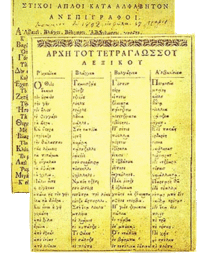Daniel Moscopolites
Daniel of Moscopole or Daniil of Moscopole (1754–1825) (Greek: Δανιήλ Μοσχοπολίτης, Daniil Moschopolitis; Aromanian: Daniil Moscopoleanu) (1754–1825) or Mihali Adami Hagi (Aromanian: Mihali Adami Hagi) was an Aromanian scholar from Moscopole, student of Theodoros Kavalliotis, 18th/19th-century professor and director of New Academy of Moscopole.
Background
In 1794, he published in Moscopole the first dictionary of four modern Balkan languages (Greek, Albanian, Aromanian and Bulgarian). Many authors published their works in both Greek and Aromanian, written in the Greek alphabet. With his lexicographic work, Daniel hoped to persuade the Albanians, Aromanians and Bulgarians to abandon their "barbaric" tongues and learn Greek, the "mother of knowledge". The book was republished in 1802 in Ragusa, Dubrovnik[6] or Venice.[7]
Work
Daniel in his work Εισαγωγική Διδασκαλία ("Introductory instruction"),[8] compiled a combined dictionary of Greek (Romaika), Aromanian (Vlachika), Bulgarian (Vulgarika) and Albanian (Arvanitika). Daniel invited non-Greek speakers with this dictionary to learn the Greek language:[9]
| “ | Albanians, Vlachs, Bulgarians, speaker of other languages, rejoice, and prepare yourselves all of you to become Romioi (Greeks), leaving the barbarian language, voice and customs, that to your descendants will appear like myths. | ” |
In this period Moscopole was an important Balkan city, and the cultural and commercial center of the Aromanians, and the site of the first printing press working in the Balkans.
See also
References
- ↑ Multiculturalism, alteritate, istoricitate «Multiculturalism, Historicity and “The image of the Other”» by Alexandru Niculescu, Literary Romania (România literară), Issue: 32 / 2002, pp. 22-23.
- ↑ Angeliki Konstantakopoulou, Η ελληνική γλώσσα στα Βαλκάνια 1750–1850. Το τετράγλωσσο λεξικό του Δανιήλ Μοσχοπολίτη [The Greek language in the Balkans 1750–1850. The dictionary in four languages of Daniel Moschopolite]. Ioannina 1988, 11.
- ↑ Peyfuss, Max Demeter: Die Druckerei von Moschopolis, 1731–1769. Buchdruck und Heiligenverehrung im Erzbistum Achrida. Wien - Köln 1989. (= Wiener Archiv f. Geschichte des Slawentums u. Osteuropas. 13), ISBN 3-205-98571-0.
- ↑ Kahl, Thede: Wurde in Moschopolis auch Bulgarisch gesprochen? In: Probleme de filologie slavă XV, Editura Universităţii de Vest, Timişoara 2007, S. 484-494, ISSN 1453-763X.
- ↑ "The Bulgarian National Awakening and its Spread into Macedonia", by Antonios-Aimilios Tachiaos, pp. 21-23, published by Thessaloniki's Society for Macedonian Studies, 1990.
- ↑ "Четириезичният речник на Даниил (гръцка и българска част). Годишник на Софийския университет. Факултет по западни филологии, т. LXX, София, 1976, стр. 5-180.
- ↑ J. Kristophson, Das Lexikon Tetraglosson des Daniil Moschopolitis, in: Zeitschrift für Balkanologie, 10 (1974), pp. 7-128.
- ↑ Central European University Press. Discourses of collective identity in Central and Southeast Europe (1770–1945): texts and commentaries. Central European University Press, 2006 ISBN 978-963-7326-52-3, p. 67.
- ↑ Kostantaras Dean J.. Infamy and revolt: the rise of the national problem in early modern Greek thought. East European Monographs, 2006, ISBN 978-0-88033-581-2, p. 96.
